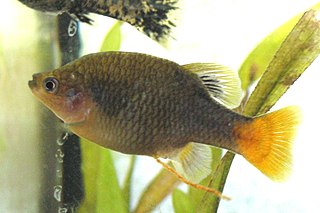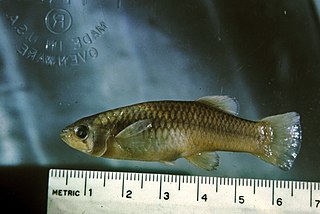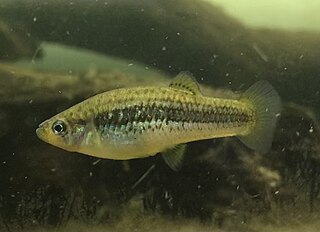
Gambusia is a large genus of viviparous fish in the family Poeciliidae. Gambusia contains over 40 species, most of which are principally found in freshwater habitats, though some species may also be found in brackish or saltwater habitats. The genus Gambusia comes from the Cuban term, "Gambusino", which means "free-lance miner". The type species is the Cuban gambusia, G. punctata. The greatest species richness is in Mexico, Texas, and the Greater Antilles, but species are also found elsewhere in the eastern and southern United States, the Bahamas, Central America, and Colombia. Gambusia species are often called topminnows, or simply gambusias; they are also known as mosquitofish, which, however, refers more specifically to two species, G. affinis and G. holbrooki, which are often introduced into ponds to eat mosquito larvae. As a consequence, they have been introduced widely outside their native range, and frequently become invasive, threatening local species. G. affinis and G. holbrooki are now established in many parts of the world and are likely to continue to spread as climatic conditions change. They are only occasionally kept in aquariums, due to their relative lack of color and the highly aggressive nature of the aforementioned mosquitofish species.

Goodeidae is a family of teleost fish endemic to Mexico and some areas of the United States. Many species are known as splitfins. This family contains about 50 species within 18 genera. The family is named after ichthyologist George Brown Goode (1851-1896).

The San Marcos River rises from the San Marcos Springs, the location of the Meadows Center for Water and the Environment, in San Marcos, Texas. The springs are home to several threatened or endangered species, including the Texas blind salamander, fountain darter, and Texas wild rice. The river is a popular recreational area, and is frequented for tubing, canoeing, swimming, and fishing.

The Ash Meadows killifish is a species of killifish from the subfamily Empetrichthyinae, part of the family Goodeidae, which was first documented by C. H. Gilbert in 1893 and historically occupied numerous springs near Ash Meadows, Nye County, Nevada, United States. This species was last seen in 1948 and is believed to have gone extinct in the early 1950s, likely as a result of habitat alteration and competition with and predation by introduced crayfish Procambarus clarkii, mosquitofish, black mollies, and bullfrogs.

The eastern mosquitofish is a species of freshwater fish, closely related to the western mosquitofish, Gambusia affinis. It is a member of the family Poeciliidae of order Cyprinodontiformes. The eastern mosquitofish is native to the eastern and southern United States from Florida to Pennsylvania and inland to Alabama and Tennessee, while the western mosquitofish has a larger distribution throughout the United States.

The White River springfish is a species of fish in the family Goodeidae, the splitfins. It is a rare species of the Great Basin of western United States, where it is endemic to isolated warm springs in the White River drainage of eastern Nevada.
George Sprague Myers was an American ichthyologist who spent most of his career at Stanford University. He served as the editor of Stanford Ichthyological Bulletin as well as president of the American Society of Ichthyologists and Herpetologists. Myers was also head of the Division of Fishes at the United States National Museum, and held a position as an ichthyologist for the United States Fish and Wildlife Service. He was also an advisor in fisheries and ichthyology to the Brazilian Government.
The yellowfin gambusia is a species of fish in the family Poeciliidae. It is endemic to the Rio Conchos of Chihuahua, Mexico, where it is known as guayacon de san gregorio. This species was described in 1957 by Clark Hubbs and Victor G. Springer with the type locality given as El Ojo de San Gregorio in Chihuahua. The specific name of this fish honours the Mexican ichthyologist José Alvarez del Villar (1903-1986) for his work on the fishes of Mexico and for his assistance to Clark and Springer.

The Big Bend gambusia is a rare species of fish in the family Poeciliidae. It is endemic to the Big Bend region of the Rio Grande of the United States and Mexico. The only known remaining population is in a protected pond in the Big Bend National Park.

Gambusia hurtadoi, also known as crescent gambusia, is a species of fish in the family Poeciliidae. It is endemic to Chihuahua in Mexico, where it is known as guayacon de Hacienda Dolores. It grows to 3.5 cm (1.4 in) total length. The species was described in 1957 by Carl Leavitt Hubbs and Victor G. Springer with the type locality given as El Ojo de la Hacienda Dolores, 7 miles south of Jiminez, Chihuahua, the spring to which this species is endemic. Hubbs and Springer honoured the Mexican Leopoldo Hurtado Olin of the Departamento de Economía in Chihuahua for his assistance during their collecting expedition to Chihuahua in June 1951. Hurtado Olin also informed Hubbs and Springer of the location of El Ojo de la Hacienda Dolores.
Gambusia krumholzi is a species of fish in the family Poeciliidae endemic to Mexico.

The konye (Konia eisentrauti) is a critically endangered species of fish in the family Cichlidae. It is endemic to Lake Barombi Mbo, a crater lake in western Cameroon. It is threatened because of pollution and sedimentation due to human activities, and potentially also by large emissions of carbon dioxide (CO2) from the lake's bottom (compare Lake Nyos). This species can reach a length of 9.3 centimetres (3.7 in) TL.

The Mexican blind brotula is a species of viviparous brotula endemic to Mexico, where it is found in sinkholes and caves. It is known as sak kay in Mayan and dama blanca ciega in Spanish. This cavefish grows to a standard length of 9.7 cm (3.8 in). It is the only known member of its genus.
The yellow swordtail is a species of freshwater fish in the family Poeciliidae. It is endemic to the upper Coatzacoalcos River basin in southern Mexico. It is typically found in brooks and streams with slow current; it is less frequent in areas with strong current. The yellow swordtail is considered a threatened species by Mexican authorities. It reaches up to 5.1 cm (2.0 in) in standard length.

The marbled swordtail is a species of freshwater fish in the family Poeciliidae. It was endemic to the Rio Salado system in Coahuila, northeastern Mexico. It was restricted to springs, connected creeks and pools in waters with a pH slightly above neutral and temperatures of 16–26 °C (61–79 °F), with captive studies indicating that the optimum temperature is around 24 °C (75 °F).

The ornate rainbowfish is a species of rainbowfish endemic to an area in eastern Australia, where it is native to coastal regions and sandy offshore islands in southern Queensland and northern New South Wales. It is the only known member of its genus. It is a popular aquarium fish.

The pike topminnow, more commonly known as pike killifish and sometimes referred to as topminnow, is a species of poeciliid found from Mexico to Nicaragua. It has also been introduced to Florida, USA. It is the only known member of its genus. The pike topminnow was described in 1860 by Austrian ichthyologist Rudolf Kner, who gave the type locality as Belize, which is reflected in this species' specific name.

Xiphophorus nezahualcoyotl, the mountain swordtail, is a live bearing fish in the family Poeciliidae. It is endemic to the northwestern Pánuco River basin in Mexico. The specific name of this fish refers to the poet, philosopher and emperor of Texcoco, Nezahualcoyotl (1402-1472).
Aphyocypris lini, the garnet minnow or Venus minnow, is a species of cyprinid endemic to China. It was first collected from Hong Kong by A.W. Herre in 1936. The introduction of mosquitofish and habitat destruction caused the extirpation of this species from Hong Kong and the species was considered to be extinct in the wild. However, a similar species Aphyocypris pulchrilineata was discovered in Guangxi in southern China, but this species lacks the dark spot on the base of the caudal fin.
Clark Hubbs was an American ichthyologist who was professor of zoology at the University of Texas from 1963 until he accepted emeritus status in 1991. He was a leading figure in ichthyology in Texas, teaching many students who went on to be renowned in the field, was actively involved in many ichthyological societies and was an editor of scientific journals. Hubbs was also an environmental activist, fighting to conserve freshwater ecosystems.
















